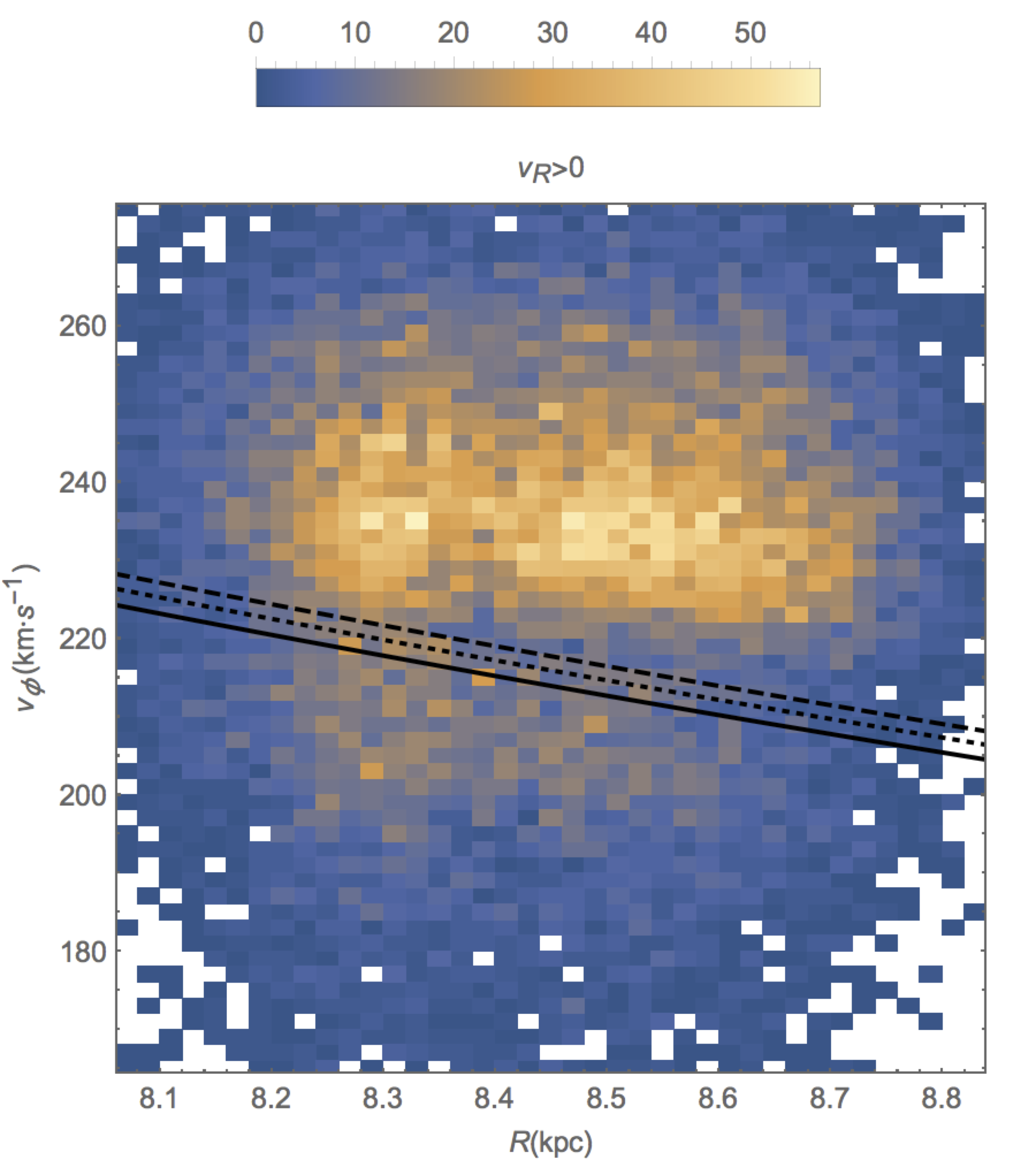IoW_20161125 - Gaia
Image of the Week |
|||
A signature of the rotation of the galactic Bar in the outer milky way |
|||
 |
|||
|
Distribution of stars with positive Galactocentric cylindrical radial velocity from the cross-matched TGAS and LAMOST catalogues, displaying their azimuthal rotation velocity as a function of Galactocentric cylindrical radius. Stars with parallax accuracy better than 20% were selected. The bin size is 20 pc in radius, and 2 km s-1 in velocity, and the units of the colour bar indicate the number of stars per bin. The three curves indicate the theoretical position of the gap between the high and low-velocity modes for three different shapes of the Galaxy rotation curve, and for a fast pattern speed of the bar of 54 km s-1 kpc-1. These theoretical curves correspond to the observed gap. |
|||
|
Our Milky Way galaxy is a barred galaxy, meaning that it harbours an elongated stellar structure in its central parts. The actual structure of the Milky Way bar is, however, still highly controversial. Old estimates of the length of the bar favoured a relatively short bar rotating at a fast pace, but recent investigations of the inner Galaxy have rather tended to favour a long bar extending from the Galactic centre to more than half-way to the Sun. Such a long bar must rotate more slowly than a short one. The effect of the rotation of the Galactic bar can actually affect the motion of stars in the vicinity of the Sun in the Galaxy, due to a mecahnism known as a "resonance". A resonance with the bar occurs when the frequency of radial oscillations (how close or far from the Galactic center a star gets along its orbit) matches the rotation frequency of the star with respect to the bar. Resonating stars feel a very regular gravitational pull from the bar that modifies their orbit. Using data from the TGAS/Gaia DR 1 catalogue on parallaxes and proper motions, and combining them with data from a ground-based spectroscopic survey based in China (LAMOST) a group of astronomers from France, Sweden, UK, and Canada have uncovered the signature of the resonance with the rotation of the bar in the velocities of stars located in the outer parts of the Galaxy with respect to the Sun. This signature is shown in the image above, which indicates that the azimuthal rotation velocity of stars has a bimodal distribution, with a gap separating the high-velocity mode from the low-velocity mode. The position of this gap as a function of radius is a direct indication of the pattern speed of the bar, and the authors could conclude that the bar is indeed rotating fast, and must thus in principle be shorter than the recent investigations of the inner Galaxy indicate. An article on this was just accepted at the Monthly Notices for the Royal Astronomical Society (MNRAS) and is also available through arXiv. This research was performed by Giacomo Monari of the University of Strasbourg funded through a CNES grant, and who recently moved to the Oskar Klein Centre for Cosmoparticle Physics), Daisuke Kawata from Mullard Space Science Laboratory, Jason Hunt from the Dunlap institute for Astronomy and Astrophysics, and Benoit Famaey, CNRS researcher at the University of Strasbourg. |
|||
|
Credits: Giacomo Monari & Benoit Famaey (CNES, Observatoire astronomique de Strasbourg, Stockholm University) and Daisuke Kawata & Jason Hunt (MSSL, University of Toronto) [Published: 25/11/2016] |
|||
- Removed a total of (9) style text-align:center;
- Removed a total of (7) style text-align:justify;
- Removed a total of (1) border attribute.
- Removed a total of (1) cellpadding attribute.
- Removed a total of (1) cellspacing attribute.
Image of the Week Archive
- Removed a total of (1) border attribute.
- Removed a total of (1) cellpadding attribute.
- Removed a total of (1) cellspacing attribute.








































 Sign in
Sign in
 Science & Technology
Science & Technology